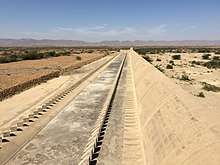Hub Dam
Hub Dam (Urdu: حب ڈیم ) is a reservoir on the Hub River. It is situated 56 km from Karachi city in Karachi and Lasbela Districts on Sindh and Balochistan provinces border. The dam is extended to 24300 acres with gross storage capacity of 857000 acre feet. It is the Pakistan's third-largest dam. It is an important source that provides the drinking water to the metropolitan city Karachi.[4]
| Hub Dam | |
|---|---|
.jpg) | |
| Official name | حب ڈیم |
| Country | Pakistan |
| Location | Sindh-Balochistan provincial border 45 kilometres (28 mi) north-east of Karachi |
| Coordinates | 25°15′21″N 67°6′51″E |
| Purpose | Municipal Industrial Irrigation[1] |
| Construction began | September 1963[1] |
| Opening date | June 1981[1] |
| Construction cost | ₨1191.806 million (US$7.2 million)[1] |
| Operator(s) | WAPDA |
| Dam and spillways | |
| Type of dam | Earth fill dam |
| Impounds | Hub river Shoring Nullah |
| Reservoir | |
| Total capacity | 687,276 acre⋅ft (0.847742 km3)[2] |
| Active capacity | 656,000 acre⋅ft (0.809 km3)[1] |
| Inactive capacity | 41,806 acre⋅ft (0.051567 km3)[2] |
| Catchment area | 3,410 square miles (8,800 km2)[2] |
| Surface area | 29.06 square miles (75.3 km2)[2] |
| Installed capacity | .5v MW |
| Designated | 10 May 2001 |
| Reference no. | 1064[3] |


In 1974, the government of Sindh declared the area around dam as a wildlife sanctuary. The sanctuary is about 27219 hectors in size. It is favorable area for feeding and nesting for Cranes, Pelicans, Ducks and Waders. It also an important habitat of migratory birds. The Dam was designated a Ramsar site on 1 May 2001.[4]
Hub Dam is also a tourist resort. On weekend holidays many people from Karachi visit to enjoy picnics, swimming and fishing.[4] A rest house of WAPDA is also located there for tourists stay.
Historical records
Before winters rains in February and March 2019 the level of water in the dam had dropped to 276ft. A spell of rains in southwestern province of Balochistan in February and March 2019 has led to increase in the water level at Hub dam, raising the level to 348 feet by 70 feet till March 03, 2019.[5]
References
- "Hub Dam". Retrieved 3 June 2017.
- "Hub Dam – Main Features". Retrieved 3 June 2017.
- "Hub Dam". Ramsar Sites Information Service. Retrieved 25 April 2018.
- "Hub Dam Wildlife Sanctuary". Sindh Wildlife Department. Archived from the original on June 27, 2013. Retrieved May 21, 2012.
- https://www.dawn.com/news/amp/1467492
